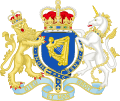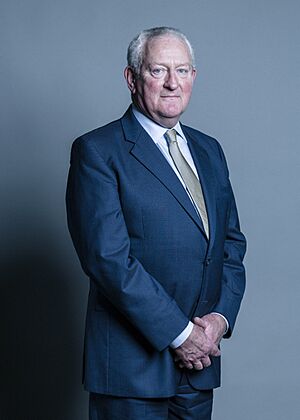Lord High Steward of Ireland facts for kids
Quick facts for kids Lord High Steward of Ireland |
|
|---|---|

Unofficial arms of Kingdom of Ireland
|
|
| Style | The Right Honourable |
| Formation | 1446 |
| First holder | The 1st Earl of Shrewsbury |
| Succession | Hereditary |
| Deputy | Vice Great Seneschal / Deputy Lord High Steward |
The Lord High Steward of Ireland is a very old and important job in the United Kingdom. It's a special position that gets passed down from parent to child, like a family heirloom. The person who holds this title is called a Great Officer of State.
Right now, the Earl of Shrewsbury holds this role. Sometimes, people also call him the Hereditary Great Seneschal. Even though most of Ireland became independent in 1922, the title still uses its original name. It doesn't just refer to Northern Ireland, which is the part of Ireland still connected to the UK.
The first Lord High Steward of Ireland was John Talbot, 1st Earl of Shrewsbury. King Henry VI gave him this title in 1446. The King also made him the Earl of Waterford. The title was meant to be passed down through the male members of his family. This family line has continued without a break for over 570 years! The current Earl of Shrewsbury is the 22nd person to hold this ancient office.
Contents
What is a Lord High Steward?
A Lord High Steward is a very senior official. They have important duties, especially during big royal events. This role is one of the highest Great Officers of State.
Comparing Roles in England and Scotland
The job of Lord High Steward in England is different. It's not passed down through families anymore. For example, the Duke of Northumberland held the English position for the King's Coronation in 1911. The English Lord High Steward is like a top judge in Parliament. They also lead the new King or Queen in parades. They carry the Crown of St. Edward on a soft cushion in front of the monarch. They wear fancy robes of white satin and gold, with a long red cloak.
Scotland also has a similar role called the Prince and Great Steward of Scotland. This job usually belongs to the Duke of Rothesay. The current Duke of Rothesay is also the Prince of Wales. He has many other important duties because of these titles. So, for the last two Coronations, the Earl of Crawford stepped in. He acted as a deputy to carry out the duties for the Prince and Great Steward of Scotland.
The Lord High Steward of Ireland is unique because it's always been passed down in the Shrewsbury family. In 1862, the Attorney General explained what this office meant. The title's history goes back to King Henry II. He gave the job of Lord High Steward of Ireland to Sir Bertram de Verdun. A writer named William Lynch wrote a lot about how this old title was passed down through families.
How the Office is Passed Down
Some special jobs, like the Lord High Steward of Ireland, can be passed down through families. This means the person holding the office and their future family members can keep it. These types of jobs are called "hereditary offices."
In the past, some of these jobs were connected to land. For example, the Lord Constable of Ireland was given to Hugh de Lacy, Lord of Meath in 1185. This job came with land. Over time, the land was divided, and the job eventually stopped being actively used.
The title of Seneschal was brought back in 1444 for John Talbot. He was created Earl of Shrewsbury. His wife was related to a family that had part of an old estate in Meath. This connection helped him become the Lord High Steward.
The Earls of Shrewsbury continued to inherit the Lord High Stewardship. In 1450, the 1st Earl of Shrewsbury, who was also the Lord High Steward of Ireland, appointed John Penyngton as Steward of the Liberty of Waterford. This showed that the Earl had the power to make such appointments. Later, in 1624, the 4th Earl of Shrewsbury's right to the office was confirmed. The House of Lords agreed in 1862 that these appointments proved the Earls of Shrewsbury were indeed the Lord High Stewards of Ireland.
The 4th Earl of Shrewsbury, George Talbot, helped at the coronation of King Henry VII in 1485. He did this because he was the Lord High Steward of Ireland. The 12th Earl also helped at King James II's coronation in 1685. In both cases, the Lord High Steward carried a special sword called the Curtana.
Challenges for the Hereditary Office
For a long time, the Earls of Shrewsbury couldn't always do their duties. This was because English Kings didn't visit Ireland often. Also, the Earls of Shrewsbury were Roman Catholics. Before 1829, laws called the Penal Laws stopped Catholics from holding important public jobs. This meant they couldn't act as judges in the role of Lord High Steward.
Because of these laws, other people had to step in. For example, in 1739, Thomas Wyndham, 1st Baron Wyndham acted as Lord High Steward of Ireland for an important legal case. This was the first time a Lord was tried by his equals in Ireland.
Another important case happened in 1743. Robert Jocelyn, 1st Viscount Jocelyn, who was the Lord Chancellor of Ireland, acted as Lord High Steward. The case ended quickly because the main witnesses had passed away. When the Lords decided the accused was not guilty, the acting Lord High Steward broke a white stick, which was a sign that his job for that trial was over.
In 1798, another peer was tried. John FitzGibbon, 1st Earl of Clare, who was also the Lord Chancellor of Ireland, took on the role of Lord High Steward. The accused was found not guilty, and the Lord High Steward again broke his stick.
The Office Returns to the Family
After the Roman Catholic Relief Act 1829 was passed, Catholics could hold public office again. This meant John, the 16th Earl of Shrewsbury, could finally take his place in Parliament. King William IV recognized the Earl's right to be Lord High Steward. He allowed the Earl to wear the special uniform and attend royal events.
This showed that even after a long time, the family's right to the office was still valid. The Earl of Shrewsbury then took his place as Lord High Steward of Ireland at King William IV's funeral. Queen Victoria also chose him to carry the Banner of Ireland. His high rank, even above some Dukes in England, was officially recognized in 1843 and 1858.
Finally, on August 1, 1862, the House of Lords officially confirmed that Henry John, the Earl of Shrewsbury and Waterford, had the right to the office of Lord High Steward of Ireland.
The White Wand of Office
The Lord High Steward carries a special white wand when performing official duties. This tradition was formally approved by Queen Victoria in 1871. She said that the Earls of Shrewsbury, as Lord High Stewards of Ireland, could carry this white wand at state ceremonies.
This white wand has been used at many coronations, including those of King Edward VII in 1902, King George V in 1911, and King George VI in 1937.
The white wand is a symbol of the Lord High Steward's important role as a judge. When a temporary Lord High Steward is appointed for a specific trial, they break the white wand at the end of the trial. This shows that their temporary job is finished. However, since the Earl of Shrewsbury holds the office permanently, he gets to keep his wand.
The white wand is also important in old Irish traditions. It was used when ancient Irish Kings were officially recognized. It showed that the King would rule fairly and with justice, not with force. Similarly, in Scotland, a white wand is a symbol for Barons, showing their leadership.
The Lord High Steward has also been known as the Great Seneschal of Ireland. A Seneschal was also a manager of a large estate or manor in Ireland. More recently, the term Seneschal was used for Donal Buckley, who was the Governor-General of the Irish Free State in 1932.
Deputies and Assistants
Sometimes, the Lord High Steward can appoint someone to help them. This person is called a deputy. This idea of having a deputy is very old. In 1220, King John allowed John Marshal, the Lord Marshal, to appoint a deputy. Also, in Scotland, the Earl of Crawford has acted as a deputy for the Lord High Steward of Scotland.
The Lord High Steward of Ireland can also appoint deputies, sometimes called "stewards" or "seneschals," for different areas. These deputy roles can also be passed down through families. For example, the Grand Almoner of England, the Grand Carver of England, and the Grand Falconer all have hereditary deputies.
Even though the Lord High Steward's power to appoint deputies wasn't used much during the time of the Penal Laws or when Kings didn't visit Ireland, it still exists. This power has been used for some appointments in the 20th century. These appointments have been accepted by the Court of Claims, which checks who has the right to perform duties at Coronations.
One special deputy role is the Lord Steward for Tyrconnell. This job is given by the Lord High Steward of Ireland and is passed down through the family. Patrick Denis O'Donnell held this position, and now his son, Francis Martin O'Donnell, has inherited it. There are also a few other honorary deputy positions for the Lord High Steward of Ireland.
Lord High Stewards of Ireland, 1446-present
- 1446–1453: John Talbot, 1st Earl of Shrewsbury and Waterford
- 1453–1460: John Talbot, 2nd Earl of Shrewsbury and Waterford
- 1460–1473: John Talbot, 3rd Earl of Shrewsbury and Waterford
- 1473–1538: George Talbot, 4th Earl of Shrewsbury and Waterford
- 1538–1560: Francis Talbot, 5th Earl of Shrewsbury and Waterford
- 1560–1590: George Talbot, 6th Earl of Shrewsbury and Waterford
- 1590–1616: Gilbert Talbot, 7th Earl of Shrewsbury and Waterford
- 1616–1617: Edward Talbot, 8th Earl of Shrewsbury and Waterford
- 1617–1630: George Talbot, 9th Earl of Shrewsbury and Waterford
- 1630–1654: John Talbot, 10th Earl of Shrewsbury and Waterford
- 1654–1667: Francis Talbot, 11th Earl of Shrewsbury and Waterford
- 1667–1718: Charles Talbot, 1st Duke of Shrewsbury, 12th Earl of Shrewsbury and Waterford
- 1718–1743: Gilbert Talbot, 13th Earl of Shrewsbury and Waterford
- 1743–1787: George Talbot, 14th Earl of Shrewsbury and Waterford
- 1787–1827: Charles Talbot, 15th Earl of Shrewsbury and Waterford
- 1827–1852: John Talbot, 16th Earl of Shrewsbury and Waterford
- 1852–1856: Bertram Arthur Talbot, 17th Earl of Shrewsbury and Waterford
- 1856–1868: Henry John Chetwynd-Talbot, 18th Earl of Shrewsbury and Waterford
- 1868–1877: Charles John Chetwynd-Talbot, 19th Earl of Shrewsbury and Waterford
- 1877–1921: Charles Henry John Chetwynd-Talbot, 20th Earl of Shrewsbury and Waterford
- 1921–1980: John George Charles Henry Alton Alexander Chetwynd Chetwynd-Talbot, 21st Earl of Shrewsbury and Waterford
- 1980–present:Charles Henry John Benedict Crofton Chetwynd Chetwynd-Talbot, 22nd Earl of Shrewsbury and Waterford
Deputized Lord High Stewards of Ireland
These people were appointed to lead trials of Peers in the Irish House of Lords. Their role was temporary and focused on the legal part of the job.
- 1739: Thomas Wyndham, 1st Baron Wyndham (1681–1745)
- 1743: Robert Jocelyn, 1st Viscount Jocelyn (1727–1756)
- 1798: John FitzGibbon, 1st Earl of Clare (1749–1802)
See also Vice Great Seneschal of Ireland


